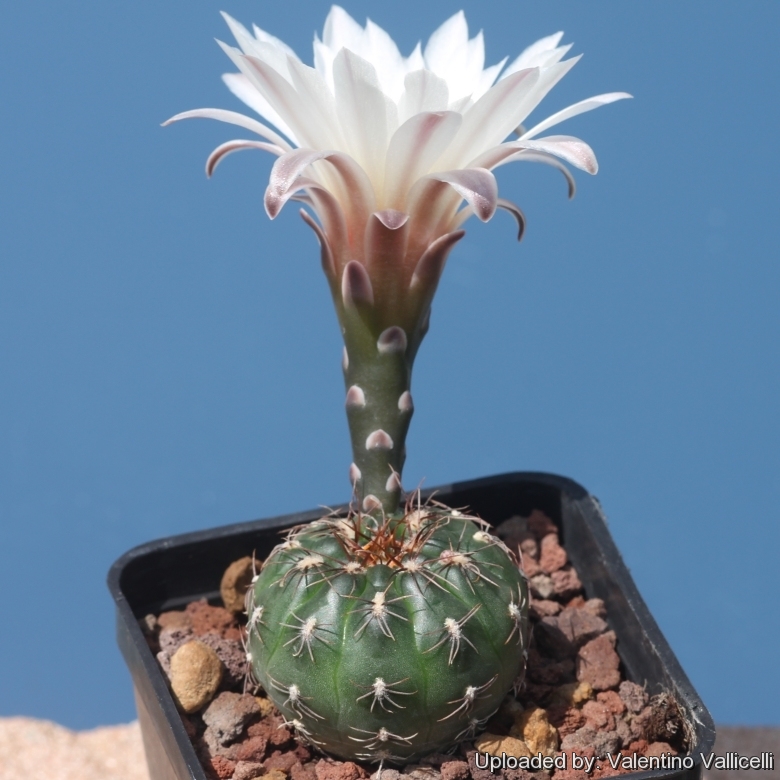
Gymnocalycium taningaense Photo by: Valentino Vallicelli
Origin and Habitat: Argentina, Córdoba (Taninga, Santa Teresita, La Mudana, Las Palmas, San José del Morro, Sierra del Morro, Villa Viso, Villa Viso, Salsacate, El Mirador, Cienaga, Bella Vista, El Cerro, La Tablada, Los Poleos , Cienaga Del Coro, San Geronimo, Villa San Luis, Las Condores, Los Poleos), San Luis (La Esquina, Puerta del Molle). Extent of occurrence is 2,800 km2
Type Locality: Arroyo San Antonio.
Altitude: 500-1500 metres above sea level.
Habitat: It grows on flat bushy terrain in the "chaco forest", meadows and moderately steep slopes of bedrock on sandy soil with rock inclusions often along with Prosopis sp. and the palm Butia yataySN|24256]]SN|24256]]. The species has a large distribution and is abundant. There are no major threats affecting this species.
Synonyms:
See all synonyms of Gymnocalycium taningaense
Description: Gymnocalycium taningaenseSN|16401]]SN|25309]] is a small cactus barely rising above ground level, usually solitary in habitat, but often branching basally in cultivation and forming clusters. It differs from the related Gymnocalycium calochlorumSN|25309]]SN|16401]] for the yellow throat of the flower (Red in calochlorum), for the slender narrower flower tube and for the bigger sized seeds.
Roots: Fibrous roots.
Stems: Flattened globose, crown slightly depressed, grey-green with a silky sheen, 4,5-6 cm in diameter and less than 2,5 cm tall (in cultivation up to 4 cm)
Ribs: 9-11, shallow, up to 12 mm wide, with weak chinlike protrusions.
Areoles: Rounded, slightly sunken, 2-3 mm in diameter, white tomentose, 5-7 mm apart.
Spines: Reddish brown to greyish brown darker at the base, later grey, thin, needle-like, straight to slightly curved.
Central spines: 1-2, often wanting, to 11 mm long pointed downward, reddish-brown to grey, darker at the base, also needle weak.
Radial spines: 7-10, pointing sideways or downward, 3-8 mm long.
Flowers: Slender white with yellowish throats, 4-5,5 cm long, 3-4,5 cm in diameter. Pericarpel 1,4 to 2 cm long, 4-7 mm wide, olive to dark green, frosted. Scales approx. 4 mm wide and 3 mm long, semicircular with whitish tips. Outer perianth segments 15-22 mm long, 5 mm wide, obtusely lanceolate, white with a pale brownish middle stripe inside and outside, the inner perianth segments up to 20 mm long, up to 3 mm wide, acute-lanceolate, white, pale yellow at the base. Filaments up to 1 cm long, greenish-yellow, anthers yellow, round, 0,5-1 mm long. Pistil pale green, almost white on top, 10-12 mm long, stigma lobes usually 8 to 4 mm long, white to yellow, nectar chamber about 2 mm high, tubular, pale pink.
Fruits: 15-30 cm long, usually oval to club shaped, blue-green, with a grey-bluish pruine coat, splitting open by one to three longitudinal cracking.
Seeds: About 1,2 to 1,4 mm long, 1,0 to 1,2 mm wide, dull black.
Subspecies, varieties, forms and cultivars of plants belonging to the Gymnocalycium taningaense group
 Gymnocalycium taningaense Piltz: has greys-green stems barely rising above ground level. Radial spines 7-11reddish brown pointing sideward or downward. Centralls 1-3. Distribution: Argentina, Córdoba and San Luis.
Gymnocalycium taningaense Piltz: has greys-green stems barely rising above ground level. Radial spines 7-11reddish brown pointing sideward or downward. Centralls 1-3. Distribution: Argentina, Córdoba and San Luis.- Gymnocalycium taningaense var. lukasikii (Halda & Kupčák) Neuhuber: has brownish-grey stems barely rising above ground level and creamy-white flowers. Distribution: Sierra del Morro, San Luis, Argentina.
Bibliography: Major references and further lectures
1) Kakteen und andere Sukkulenten (41)2: 22 1990
2) Edward Anderson “The Cactus family” Timber Press, Incorporated, 2001
3) David R Hunt; Nigel P Taylor; Graham Charles; International Cactaceae Systematics Group. "The New Cactus Lexicon" dh books, 2006
4) Demaio, P. & Trevisson, M. 2013. Gymnocalycium taningaense. In: IUCN 2013. "IUCN Red List of Threatened Species." Version 2013.2. <www.iucnredlist.org>. Downloaded on 05 January 2014.
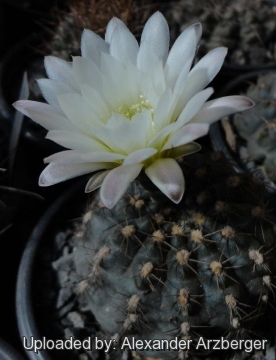 Gymnocalycium taningaense Photo by: Alexander Arzberger
Gymnocalycium taningaense Photo by: Alexander Arzberger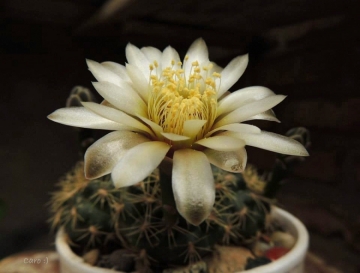 Gymnocalycium taningaense Photo by: Carolina González
Gymnocalycium taningaense Photo by: Carolina González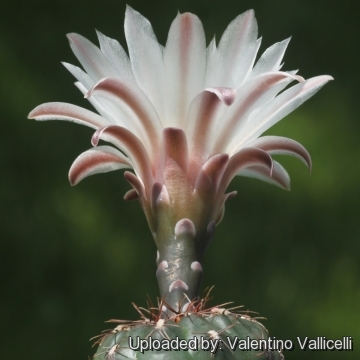 Gymnocalycium taningaense Photo by: Valentino Vallicelli
Gymnocalycium taningaense Photo by: Valentino Vallicelli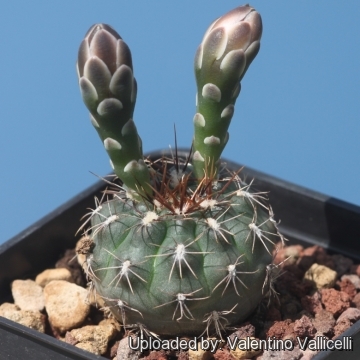 Gymnocalycium taningaense Photo by: Valentino Vallicelli
Gymnocalycium taningaense Photo by: Valentino Vallicelli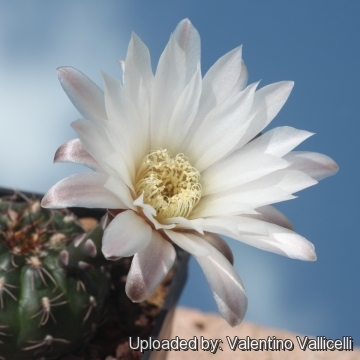 Gymnocalycium taningaense Photo by: Valentino Vallicelli
Gymnocalycium taningaense Photo by: Valentino Vallicelli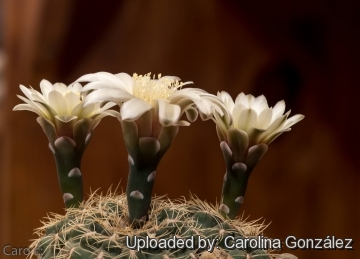 Gymnocalycium taningaense Photo by: Carolina González
Gymnocalycium taningaense Photo by: Carolina GonzálezCultivation and Propagation: Gymnocalycium taningaenseSN|25309]]SN|25309]] is a summer grower species that is easy to cultivate.
Growth rate: It is a relatively rapidly growing and easily flowering species that will make clumps given the best conditions.
Soils: It likes very porous standard cactus mix soil. pH neutral or acidic, avoid substrata rich in limestone.
Repotting: Use pot with good drainage.
Watering: Needs moderate to copious waterings in summer, but do not overwater (Rot prone), keep dry in winter.
Fertilization: Feed with a high potassium fertilizer in summer.
Hardiness: Reputedly somewhat resistant to frost if kept on the dry side prior to, and during, cold weather (hardy to -5 C ° C, or less for short periods).
Exposition: Outside bright but filtered sunlight or afternoon shade, inside it needs bright light, and some direct sun. Tends to bronze in strong light, which encourages flowering and heavy spine production.
Uses: It is an excellent plant for container growing. It always looks good and stays small. It look fine in a cold greenhouse and frame or outdoor in a rockery.
Pests & diseases: It may be attractive to a variety of insects, but plants in good condition should be nearly pest-free, particularly if they are grown in a mineral potting-mix, with good exposure and ventilation. Nonetheless, there are several pests to watch for:
- Red spiders: Red spiders may be effectively rubbed up by watering the plants from above.
- Mealy bugs: Mealy bugs occasionally develop aerial into the new growth among the wool with disfiguring results, but the worst types develop underground on the roots and are invisible except by their effects.
- Scales: Scales are rarely a problem.
- Rot: Rot it is only a minor problem with cacti if the plants are watered and “aired” correctly. If they are not, fungicides won't help all that much.
Propagation: Division, direct sow after last frost. Seeds germinate in 7-14 days at 21-27° C in spring, remove gradually the glass cover as soon the plants will be well rooted (ca 1-2 weeks) and keep ventilated, no full sun for young plants! To make a cutting twist off a branch and permit it to dry out a couple of weeks, lay it on the soil and insert the stem end partially into the soil. Try to keep the cutting somewhat upright so that the roots are able to grow downward.
















